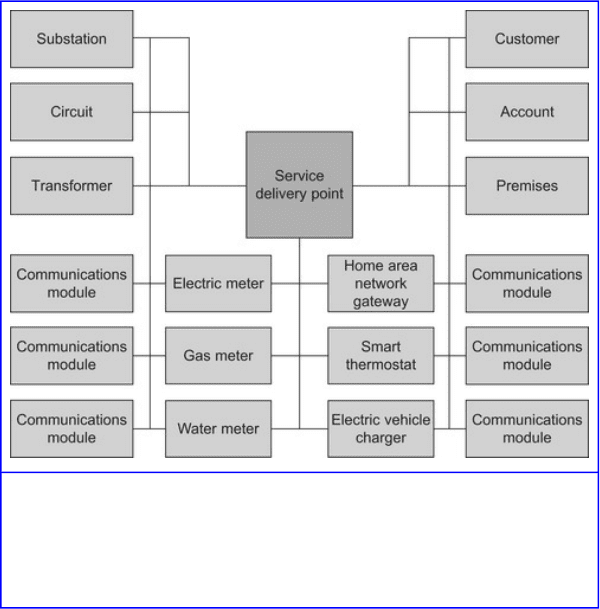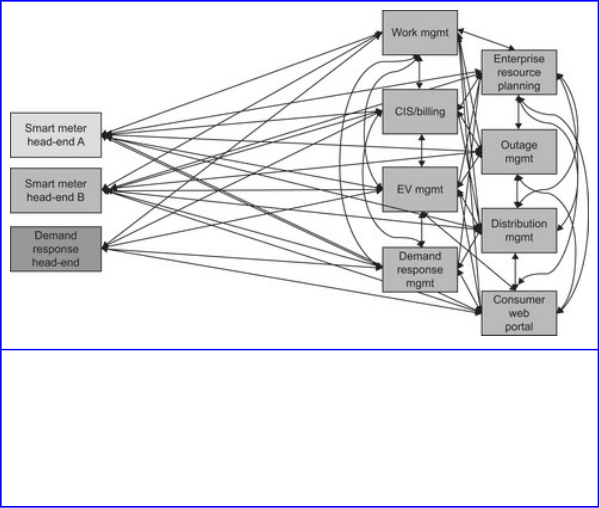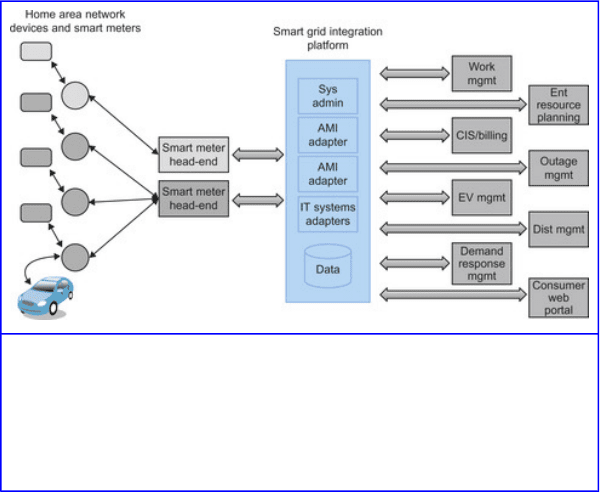Sioshansi F.P. Smart Grid: Integrating Renewable, Distributed & Efficient Energy
Подождите немного. Документ загружается.


Figure 11.3
The data model tracks relationships between a service delivery point and
various devices, grid connections, and premises data.
Source: Chris King, MDM Implementation Course, October 2010
To assist in utilizing the data, the data model may also
support tracking of the electrical connectivity of devices. For
example, the database could track to which distribution
substation, feeder, and transformer a smart meter is
connected. This would assist in diagnosing the cause of an
outage reported by an alert from that meter, because the
utility would know which substation, feeder, and transformer
was involved.
561
Device Provisioning
Provisioning in this context refers to establishing the secure
logical connection between a home and an account or another
device. Linking a new Bluetooth headset with your cell phone
is one example of provisioning. It is obviously important that
it links with your cell phone, and not someone else's.
In the smart grid, provisioning is important to link a newly
installed smart meter with the correct customer account and to
link an increasing number of in-home devices to the correct
smart meter. This way, for instance, the consumption from the
correct meter is displayed on the correct device, so neighbors
are not seeing each others’ consumption. The value of this
and similar applications is described in Chapter 15.
The IT environment challenges associated with device
provisioning can be significant. The utilities in Texas struck
an innovative approach, building on their existing Smart
Meter Texas platform. Energy service providers offer
customers programs that often include in-home devices.
Rather than duplicating the function, the central Smart Meter
Texas service manages all device provisioning between these
customer devices and the utility's smart meter.
Communications Maintenance
Successful smart grid communications require that the
devices, communications network, and software applications
are all working properly. When something fails,
communication stops or data become corrupted. Utilities need
IT systems that monitor the communications processes. Some
system needs to check whether communication is operating
successfully with each device on the network and whether the
expected data exchanges are happening. For example, most
562
smart meter systems deliver data to the utility's meter data
management system at least once a day, during some
expected time window. A software application needs to check
for this delivery, meter by meter, and report which meters
have failed so send data. This is typically done in the meter
data management system but could also be done by the
head-end communications management software that runs the
smart meter network, the so-called advanced metering
infrastructure, or AMI, head-end.
The other challenge with smart grid communications is what
to do when communications fail. It is one thing to identify, as
described above, that a meter has not reported data as
expected. It is another thing to determine why the data were
not reported and how it can be fixed. The reason could be a
meter failure, a failure of the radio in the meter, a failure of
the network concentrator unit that normally receives the data
from the meter, a failure of the wide area network (WAN)
connection to the concentrator,
20
or other things such as a
power outage or temporary radio interference.
20
To clarify, the WAN is the communications link between the utility
office and communication nodes typically mounted on utility poles in
neighborhoods. From there, pole-top nodes communicate via radio
frequency or power line carrier to the meters in the areas, this being the
LAN. The meters then communicate via a separate radio or power line
carrier modem into the home or building to connect to smart devices;
this is the HAN.
Exception Management
Some IT system needs to identify the failure—also known as
an exception—diagnose possible solutions, and initiate a
resolution—all automatically—because manual processes are
cost prohibitive in a network of millions of devices.
563

Exception handling is the bane of operations departments, and
automated processing is seen by utilities as a major smart grid
benefit.
21
21
Southern California Gas Company, Advanced Metering Infrastructure
Chapter II – Summary of AMI Business Case, Testimony Filed with the
California Public Utilities Commission, September 29, 2008.
The resolution is typically one of these three approaches:
• A retry of the communications, an automated repeat
request for the information. Such retries are part of the
basic operations of the AMI head-end software. However,
retries can be initiated by upstream systems as well, such as
the meter data management system or billing system.
• Simply waiting another day. Missing meter reads in a
daily file of smart meter reads are often resolved the next
day in the regular daily meter reading process. This
happens automatically in the operation of most AMI
technologies.
• Manual intervention. A work order is created by the
meter data management system, CIS, or work management
system—or manually—and a human being takes various
steps to diagnose and solve the problem.
Integration of Software Applications
Making the smart grid work requires different IT systems to
talk to one another reliably and efficiently. The AMI
head-end software needs to talk to the meter data
management system, which needs to talk to the billing
system. Linking all of these systems can be quite
complicated. When multiple systems are involved, and each is
564

individually connected to others, the result is sometimes
called “spaghetti integration” as shown in Figure 11.4.
Figure 11.4
With the smart grid, multiple software applications must be connected with one
another to deliver the desired functionality; a common outcome is “spaghetti”
integration.
Source: Chris King, MDM Implementation Course, October 2010.
The challenge of application integration is increased by the
diversity of the systems. Some are new, others old. For
example, a brand-new AMI head-end may be connected to a
20-year-old legacy billing system. Moreover, technical
interfaces differ, ranging from modern, XML-based,
interfaces to traditional batch-based file exchanges. In
addition, timing requirements may vary substantially, with
outage management systems typically using real-time data
exchanges, while billing systems operate with nightly file
transfers.
565

Essential Smart Grid Software Platform
During the implementation of a large-scale advanced or smart
metering project, the biggest risk is not related to the meters,
the communications, nor even the installation. The greatest
potential for getting less functionality than was bargained for
or spending more money is a poorly designed information
technology (IT) architecture. Getting it right is one of the key
steps in ensuring project success. To reiterate, while there
certainly are risks associated with investing in smart metering
equipment, there are even larger risks of not investing in an
integration platform to support the smart metering investment
and enable the desired functionality.
Utilities have two overarching goals in providing electricity:
maximizing reliability and minimizing costs. These should be
the same goals of the IT design for an advanced metering
infrastructure. Reliability means timely, complete data, as
well as seamless integration with billing, outage, field
maintenance, and other essential business systems. Reducing
costs means—well—spending less money, of course.
Smart Application Integration Platform
Smart grid functions can be implemented in one of three
ways: 1) in a purpose-built smart grid integration platform, 2)
in smart grid data communications software, or 3) in existing
utility core business systems. The most reliable, cost-effective
architecture is usually the first, as shown in Figure 11.5.
566

Figure 11.5
An integration platform allows sharing of communications networks and data
by multiple utility application systems; it also supports multiple meter
communications technologies.
Chris King, MDM Implementation Course, October 2010.
Utilities have found the integration platform architecture to be
the most reliable and cost effective for several reasons:
• It centralizes all the smart meter data management
activities, linking, for example, data collection with data
management and the data warehouse. This results in fewer
personnel and less friction between business units than
might otherwise be experienced if these functions were
separated into different departments,
• It places all of the smart meter data activities in a platform
focused on meter or other endpoint data. It has reliable and
efficient operation of that platform as its sole mission.
• It effectively and safely manages the typical situation of
utilities using multiple networks and technologies, on the
567

one hand, and multiple utility core business systems on the
other hand.
• It reduces maintenance costs for both the networks and
the utility business systems, because those systems can be
operated, maintained, and even replaced on an individual
basis without requiring major modifications to the other
interconnected systems.
Issues Associated with Other IT Architectures
One alternative is to implement the smart grid platform
functions in the head-end of the smart meter communications
system. The focus of that system is the operation of the
communications network, not managing meters or data. These
systems are optimized for network operation, a very different
function from data management. Such an approach makes it
much more difficult to integrate multiple communications
technologies, a required feature of every utility as technology
evolves more and more rapidly.
Another alternative is to implement the smart grid platform
functions by modifying core utility business systems. This is
expensive because these systems are complex and were built
to provide different functions, such as billing. This also adds
risk, because the modifications to the legacy systems must
happen in parallel with smart grid implementation. In some
cases this approach would drive modifications to systems that
are scheduled for replacement even before the smart grid or
smart meters are fully deployed. These parallel activities
mean the system can focus on neither its primary
function—say billing—nor the smart metering
implementation.
568

Multiple Operating Companies/Multiple Utilities
The smart grid platform approach supports utilities with
multiple operating companies or jurisdictions where multiple
utilities and multiple communications networks are involved.
This would allow, for example, consistent business rules for
validating data to be applied across all operating companies.
If there are valid reasons for differences in the business rules,
it provides a central location to manage business rules. An
added benefit of the platform is that it also allows utilities to
work through merger-related consolidation of smart grid
communication networks into a single, common system for
use by the sister utility companies.
System Interfaces and Interoperability
Every time data are exchanged between one device and
another, or between one software system and another, the data
must pass through the interface between the devices or the
systems. This interface includes numerous layers. The
underlying layer is the physical communication: a wire, a
radio signal, or something else? Another key layer is the
communications protocol, the language the devices or
systems speak. A third important layer is the data structure.
Standards are used in each layer to enable numerous and
diverse devices and systems to work together.
The internet provides an illustration. The physical layer is
often a radio connection within the home to a router, then
over a cable wire to the cable company's data center, and from
there perhaps by microwave radio to the website host's data
center in another city. The communications protocol is IP,
569
which stands for Internet Protocol. Web pages use HTML
(hypertext mark-up language) as the data structure for the
information presented in a browser.
For the smart grid, such standards are also needed for ultimate
interoperability of devices and systems. The scope of these
standards goes beyond that of this chapter, other than to note
that the Federal Energy Independence and Security Act of
2007 mandates the development of such standards and
adoption by the Federal Energy Regulatory Commission.
22
The National Institute of Standards and Technology (NIST)
has responsibility for coordinating the adoption of these
standards. Utilities desiring to maximize the value of the
smart grid IT infrastructure are embracing these standards
where applicable and feasible.
22
H.R. 6, Energy Independence and Security Act of 2007, Section 1305,
“Smart grid interoperability framework.”
The most important standards are those that apply to
interfaces where data are exchanged between one entity and
another. One example is sharing data between utilities and
third parties authorized by customers via the OpenADE
standard (“Automated Data Exchange”).
23
Another example
is sending data from the utility-owned meter to a
customer-owned HAN device via the OpenHAN standard.
These interfaces are shown in Figure 11.6.
23
OpenADE and OpenHAN are under development under the auspices of
the National Institute of Standards and Technology. Details are available
at NIST's website for smart grid: http://www nist.gov/smartgrid/.
570
